Understanding Rosacea:
Managing the Unseen Fire Beneath the Skin

By LABRAINS | Dermatological Skincare & Clean Beauty Science
Rosacea: Not Just Redness — A Chronic Skin Imbalance
Rosacea is a chronic inflammatory skin condition with vascular, immune, and microbiome dysregulation at its core. Affecting over 400 million people worldwide, it is not curable, but highly manageable—especially with a holistic skincare routine, lifestyle adaptation, and professional guidance (source).
Rosacea manifests beyond visible redness—it’s a condition of invisible inflammation, heightened vascular reactivity, and bacterial overgrowth, including even normally harmless (commensal) bacteria. This complex imbalance leads to hypersensitivity, persistent flushing, papules, and even skin thickening or ocular irritation in advanced stages.
It is very difficult to deal with rosacea and for sure it takes a lot of time and patience, because an increasing number of studies showed a relationship between rosacea and systemic comorbidities; however, the pathophysiologic connections remain to be defined.
Managing Rosacea Holistically: How LABRAINS Strengthens Skin Tolerance & Rebuilds Natural Defense
Rosacea-prone skin is not just sensitive—it’s hyperreactive, requiring a targeted, scientific approach that rebuilds resilience, strengthens the microbiome, and prevents inflammation. While many skincare brands focus solely on symptom relief, LABRAINS takes a preventative approach, addressing the root causes of rosacea while ensuring long-term skin tolerance and defense.
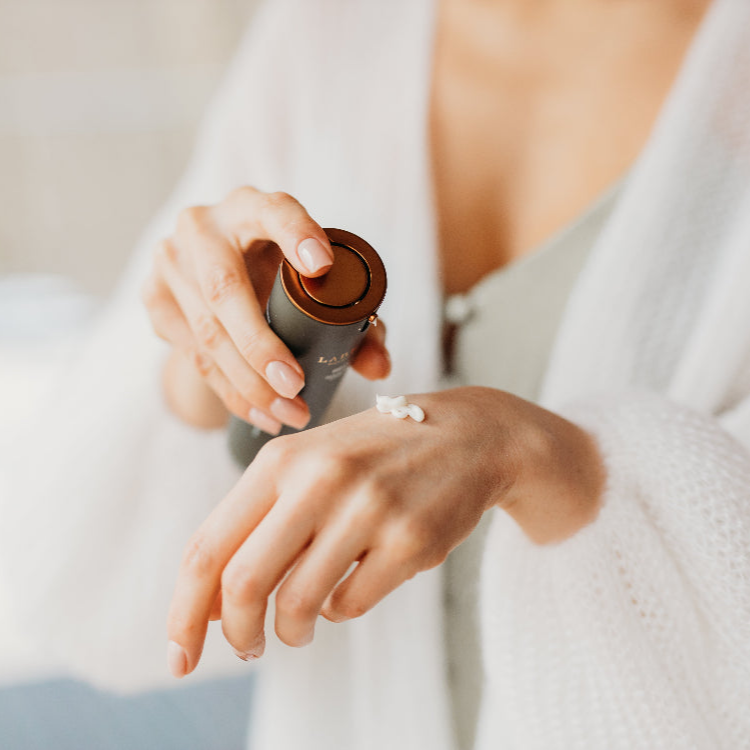
However, skincare alone is not enough. The best way to manage rosacea effectively is a holistic, science-backed approach that integrates:
- High-performance biomimetic skincare;
- Balanced lifestyle, nutrition, and hydration;
- Stress management and blue light protection;
- Proper hygiene and daily habits.
By following these key strategies, you can strengthen your skin, reduce flare-ups, and improve overall skin health.
The Science Behind Rosacea & Why It Requires a Multi-Layered Approach
Rosacea is a chronic inflammatory condition triggered by genetics, environmental factors, microbiome imbalances, and skin barrier dysfunction. The key contributors include:
- Weakened Skin Barrier – A compromised barrier (loss of lipid structure and lack of moisture) exposes skin to irritants, leading to inflammation and redness.
- Microbiome Imbalance – Overgrowth of harmful bacteria (such as Demodex mites or Cutibacterium acnes) worsens flare-ups.
- Inflammatory Response – Skin prone to rosacea overreacts to stressors, causing persistent redness and sensitivity.
- Environmental & Lifestyle Triggers – UV radiation, pollution, extreme temperatures, and blue light exposure can aggravate symptoms.
- Harsh Skincare Ingredients – Sulfates, alcohol, fragrance allergens, and conventional preservatives disrupt the microbiome and trigger redness.
Known Triggers of Rosacea (and Why They Matter Daily)
Triggers don’t always result in immediate flares—but their cumulative impact silently weakens skin resilience, setting the stage for chronic inflammation. Common rosacea triggers include:
- Sun exposure & heat (UV suppresses immune function short-term, but flares worsen in spring)
- Cold and dry wind (leads to microcracks in the barrier and ceramide loss)
- Alcohol, especially red wine (rich in vasodilators and histamines)
- Spicy foods, hot beverages, and chocolate (some rosacea patients are very sensitive to dairy products, sugars (remember about the hidden sugars in dressings and marinades)
- Stress (raises cortisol, disrupts lipid synthesis, accelerates aging)
- Systemic inflammation (gut imbalance, poor sleep, hormonal imbalance)
- Overheating (sauna, overexercise)
- Aggressive cleansing or over-exfoliation
- Wrong haircare or toothpaste with sulfates, benzoates, alcohols—they often run down the face and impact the cheek/jawline area
- Blue light and urban pollution
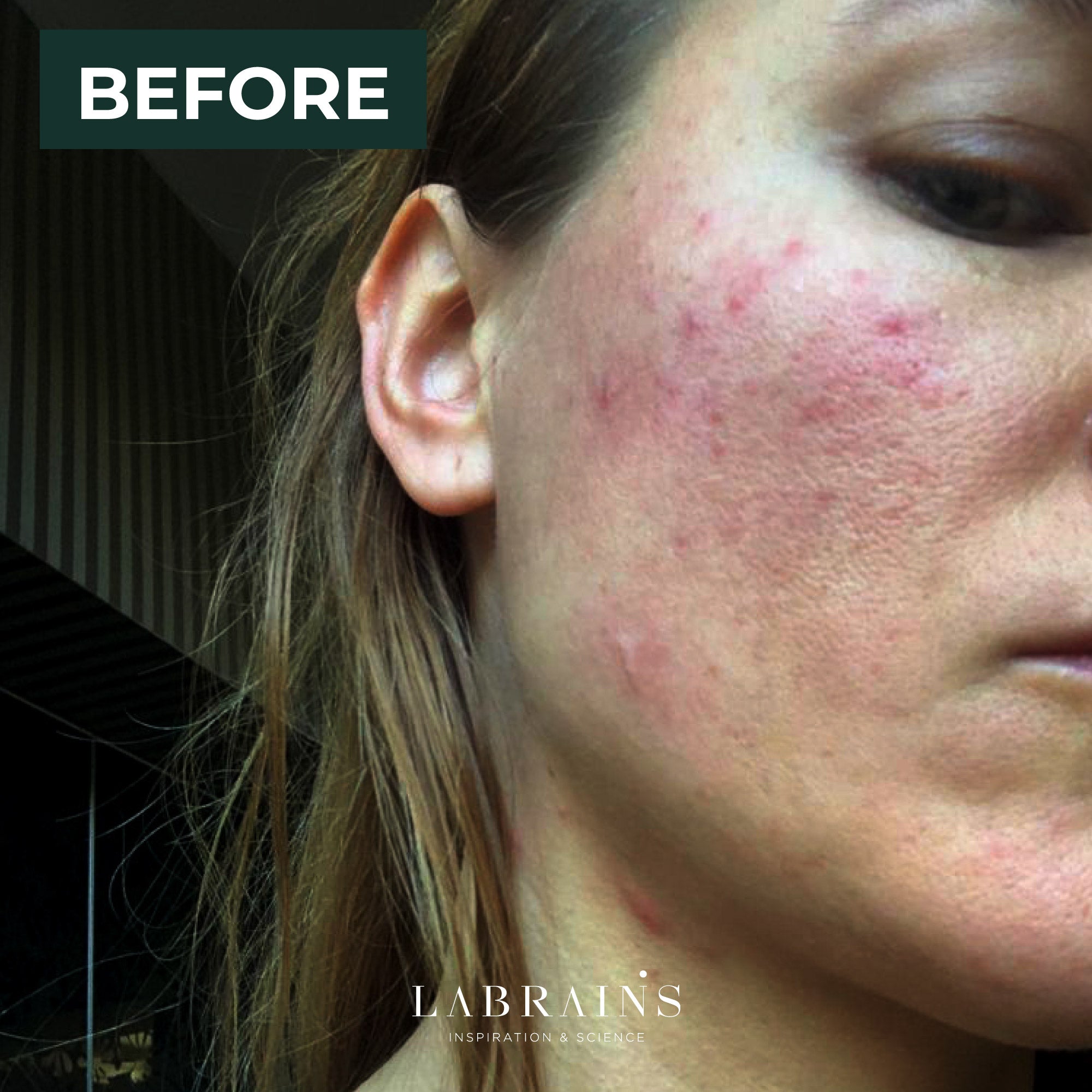
⚠️ Ingredients Rosacea-Prone Skin Should Avoid
Many conventional and even organic skincare products contain ingredients that disrupt barrier function, pH, or over-stimulate nerve endings—leading to flare-ups. Key irritants to avoid include (source):
❌ Phenoxyethanol, Benzyl Alcohol, Sodium Benzoate, Potassium Sorbate
❌ Alcohol (ethanol), glycols, and PEGs
❌ Essential oils and fragrance allergens (Limonene, Citral, Linalool, Geraniol)
❌ Sulfates (SLS, SLES, Sodium Coco-Sulfate)
❌ Synthetic penetration enhancers (glycol combinations)
❌ Acrylates, silicones, and microplastics that occlude or stress the barrier
Even in small, legally allowed concentrations, these can accumulate daily across different products, especially shampoos, sunscreens, and cleansers—triggering long-term dysregulation of skin immunity.
The Essential Role of Proper Cleansing in Rosacea Care
Rosacea-prone skin is often misunderstood—especially when it comes to cleansing. Many people believe that redness, itching, and pimples signal poor hygiene, leading them to overwash their skin in an attempt to "clean" it. However, rosacea is not caused by dirt or clogged pores alone—it's an inflammatory condition where even commensal (good) bacteria are overactive, causing fluctuations in the skin’s microbiome and immune response.
Why Overwashing is a Problem for Rosacea Skin
- Stripping away the skin’s natural Free Fatty Acids (FFAs) disrupts the skin’s defense mechanisms, leading to more irritation and dehydration.
- Disrupting the skin’s natural pH (which should be slightly acidic) allows harmful bacteria to thrive.
- Harsh surfactants, including even "natural" sulfates (like Sodium Coco-Sulfate), deplete essential lipids, leading to increased sensitivity, burning, and inflammation.
- Over-cleansing triggers a cycle of irritation—rosacea skin reacts by producing more oil and inflammation, worsening symptoms.
Instead of aggressive cleansing, rosacea skin requires a multi-step, gentle cleansing routine that:
✅ Cleanses without irritation;
✅ Balances pH to maintain microbiome health;
✅ Removes skin lipid impurities while protecting barrier function;
✅ Eliminates external pollutants & non-organic impurities without stripping moisture;
✅ Strengthens skin resilience with natural, microbiome-friendly formulations.
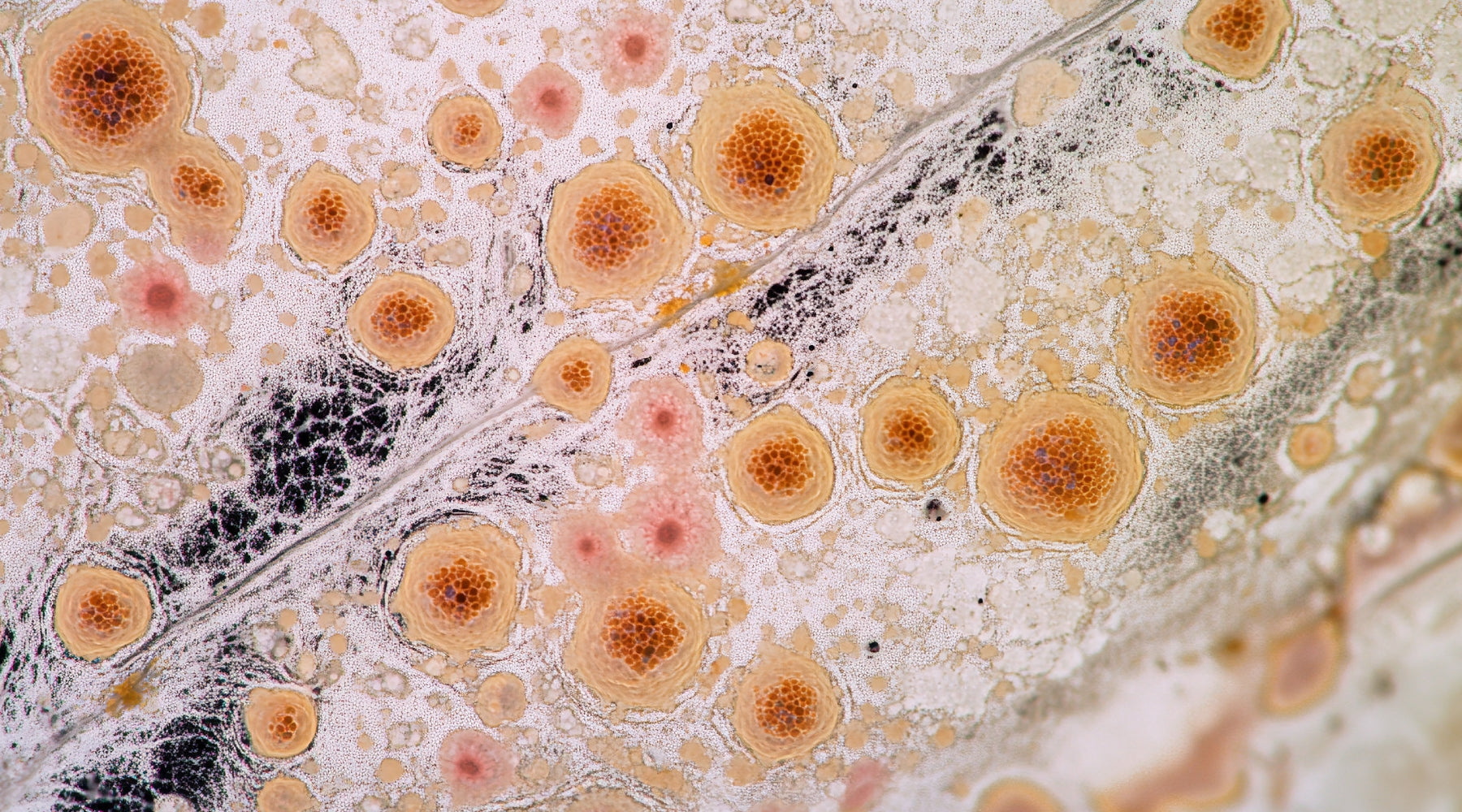
As a biochemist, LABRAINS founder Līga Brūniņa confirms: managing rosacea isn’t about “killing” bacteria - it’s about restoring balance, and that starts with smart, non-stripping cleansing.
LABRAINS’ Rosacea Cleansing & Weekly Treatment Rituals
Rosacea skin needs more than gentle cleansing—it needs microbiome protection, barrier recovery, and targeted inflammation control (source). LABRAINS offers subtype-specific 3-step rituals followed by precision-formulated weekly masks that restore balance without irritation.
🔹 Cleansing for Dry, Flushed & Vascular (ETR) Rosacea:
- Oil-to-Milk Cleanser
→ Gently dissolves impurities and sunscreen without disrupting the lipid layer. - Nordic Mud Cleanser
→ Detoxifies and remineralizes with Alpin peat, calming vascular reactivity. - Micellar Water & Tonic
→ Enriched with Lactobacillus Ferment, Hinokitiol, and Betaine to rebalance pH and microbiota.
Weekly Boost:
Skin Perfect Peeling Mask – Lactic acid (AHA) + algae and Laminaria extracts deliver controlled-release exfoliation, while boosting hydration and soothing inflammation. Designed for fragile, dehydrated rosacea skin to improve tone without barrier disruption.
🔹 Cleansing for Papulopustular Rosacea (Inflamed, breakout-prone skin):
- Nordic Mud Cleanser
→ Reduces oil imbalance and soothes inflamed follicles with humic substances. - Pore Perfect Cleanser
→ Formulated with PHA (Gluconolactone) and natural salicylates from White Willow Bark, targeting microbial imbalance and congestion gently. - Micellar Water & Tonic
→ Final step for post-cleansing calm; balances microbiome and prevents pH shifts.
Weekly Boost:
Skin Intense Peeling Mask (coming soon) – Features Azelaic Acid, Gluconolactone, natural salicylates, and peat extract to reduce breakouts, post-inflammatory pigmentation, and papular flares—without triggering sensitivity. Ideal for active inflammation control in rosacea-prone, oily skin.
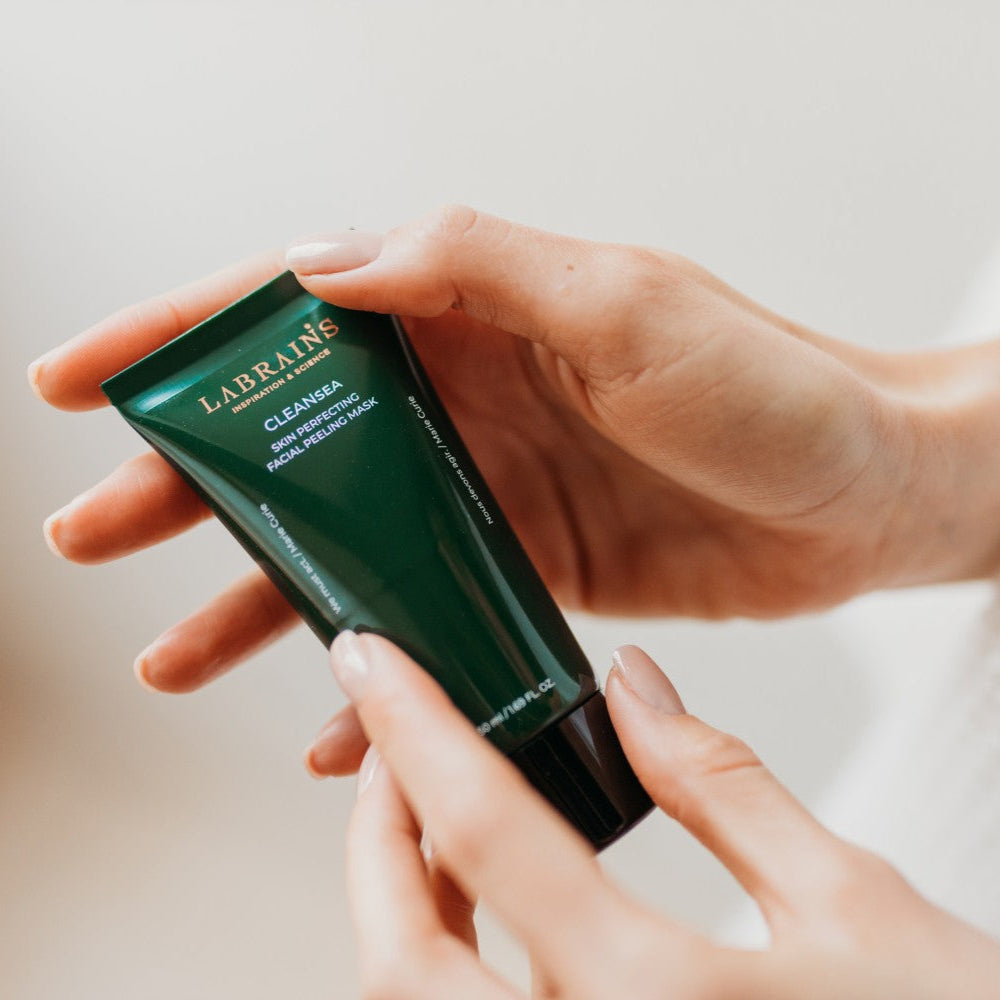
Why Peels Matter for Rosacea Skin:
Unlike traditional exfoliants, LABRAINS masks use progressive, low-irritation mechanisms like controlled-release AHAs, bioactive clays, and hydrating polysaccharides. This maintains epidermal homeostasis, supports desquamation, and resets the microbiome — without triggering flare-ups.
Pro Tip:
Start masks 1x per week. Always follow with LABRAINS moisturizers rich in ceramides, squalane, or B vitamins to rebuild the barrier.
Hygiene Tip:
Always use a fresh towel in the morning and in the evening and change the pillowcase daily—microbial replication on textiles can undo even the best cleansing effort.
The Four Clinical Subtypes of Rosacea (And Why They Can Evolve)
Rosacea is not a static diagnosis (source). It’s a dynamic, chronic skin disorder with four main clinical subtypes, which often overlap or evolve depending on skin care, inflammation, environmental stressors, and immune health.
1️⃣ Erythematotelangiectatic Rosacea (ETR)
Persistent flushing, diffuse redness, visible capillaries (telangiectasia)
Often the first sign of rosacea, ETR is typically seen in the early stages of the condition. The skin becomes hypersensitive, reactive to heat, cold, stress, spicy foods, and sun exposure.
Why caution is critical:
Early ETR can appear in teenagers or young adults, even children, often misinterpreted as simple blushing or sensitive skin. If your child shows persistent redness, it should never be ignored—early intervention is key to preventing disease progression.
2️⃣ Papulopustular Rosacea
Red, swollen skin with acne-like pustules and papules
This subtype is often mistaken for adult acne but differs by the absence of blackheads and presence of inflammation and stinging. It’s characterized by:
- Sudden breakouts, often within a few hours;
- Increased sebum and microbial overgrowth;
- Red, itchy, and burning sensation.
In this stage, the skin barrier is severely compromised. Deep-layer detoxification and inflammation control are essential, but resolution is gradual—restoring homeostasis takes time.
3️⃣ Phymatous Rosacea
Thickening skin, enlarged pores, often on the nose (rhinophyma)
This is typically seen in advanced, untreated, or mismanaged cases. The skin becomes fibrotic, oilier, and develops irregular texture and nodularity. It’s more common in men but can occur in women as well.
Treatment is complex:
Phymatous changes often require ablative laser treatments, dermabrasion, or surgical correction, as topical products alone can’t reverse tissue remodeling.
4️⃣ Ocular Rosacea
Red, dry, irritated, watery, or stinging eyes
Ocular symptoms may precede or follow skin involvement, and are often overlooked. The eye area is thin and extremely sensitive to inflammation, pollutants, and even blue light exposure.
Common signs:
- Grittiness, light sensitivity;
- Swollen eyelids or styes;
- Blurred vision in severe cases.
Ocular rosacea is often linked to systemic inflammation, and managing internal triggers (gut health, chronic stress, hormone fluctuations) is as important as external care.
Each subtype requires personalized medical and cosmetic care, often combining topicals (e.g. ivermectin, azelaic acid, metronidazole), oral antibiotics, laser therapy, and gentle skincare.
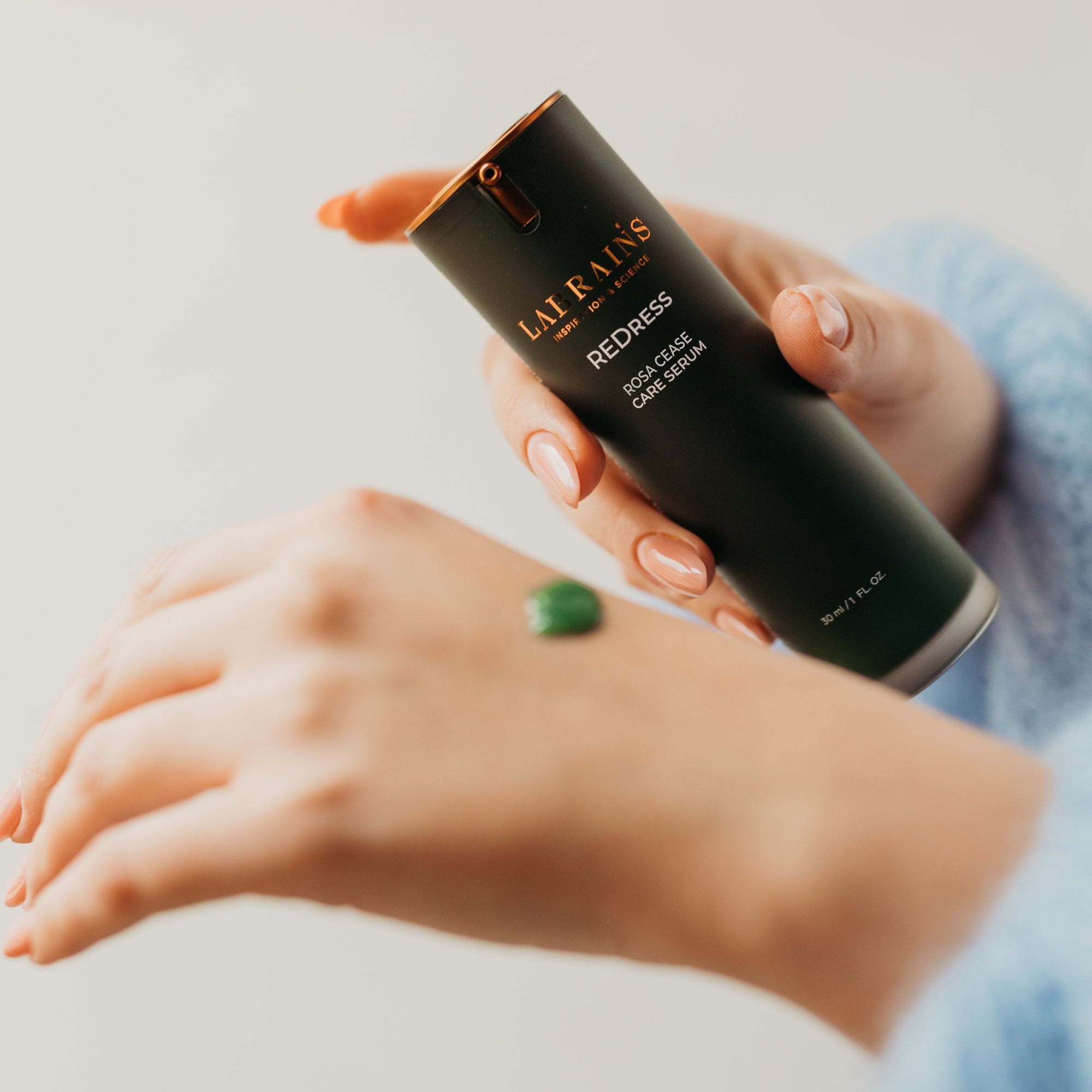
Can Rosacea Switch Between Types? Yes.
Rosacea subtypes are not rigid. Over time, a person may shift from:
- ETR → Papulopustular → Phymatous;
- Papulopustular → Ocular;
- Or have combinations of multiple types at once.
This progression is often triggered by environmental factors, misuse of cosmetics, stress, or lack of early intervention.
🚫 Skincare Mistakes That Contribute to Subtype Shift:
- Use of harsh exfoliants or alcohol-based toners;
- Fragrance and essential oil exposure (e.g. Geraniol, Citranol, Limonene, Linalool);
- PEGs, phenoxyethanol, and benzoates in leave-on products;
- Heavy occlusives or silicone-based fillers that trap heat and bacteria;
- Microparticles (including physical SPF and makeup powders) that disrupt the microbiome;
- Inappropriate cleansers that over-strip natural oils or alter pH.
What LABRAINS Offers
LABRAINS products are specifically developed to interrupt this progression by:
✔ Rebuilding lamellar structure with biomimetic emulsifiers (acts as second skin and imitate its structure to rebuilt and protect);
✔ Rebalancing microbiome with postbiotics and prebiotics;
✔ Replacing traditional preservatives with non-irritant plant-based antimicrobials;
✔ Strengthening skin with pharma-grade vitamins, ceramides, and senolytics.
With early care, especially when signs of ETR appear, it’s possible to stabilize the skin, prevent vascular changes, and reduce the risk of long-term complications.
LABRAINS’ 5-Step Approach: How to Prevent & Manage Rosacea
1️⃣ Strengthening the Skin Barrier with Biomimetic Formulations
Rosacea-prone skin lacks a strong protective layer, making it more vulnerable to external irritants. The best way to restore resilience is through lamellar-structured formulations, which mimic the skin’s lipid matrix for enhanced hydration and defense.
LABRAINS’ Best Barrier-Strengthening Ingredients:
- Hydrogenated Lecithin – Restores skin lipids, improving resilience and reducing moisture loss.
- Squalane & Ceramide NP – Help seal in hydration while protecting against irritation.
- Caprylic/Capric Triglyceride – A lightweight, non-comedogenic emollient that prevents dehydration.
2️⃣ Supporting the Microbiome to Prevent Flare-Ups
The skin microbiome plays a critical role in rosacea. An imbalance can lead to redness, irritation, and an overactive immune response. LABRAINS avoids traditional preservatives (like phenoxyethanol, sodium benzoate, and benzyl alcohol) that disrupt skin flora and instead uses a microbiome-friendly approach.
Microbiome-Supporting Ingredients:
- Lactobacillus Ferment – A postbiotic that nourishes beneficial bacteria, reducing breakouts and inflammation.
- Sodium Levulinate & Sodium Anisate – Preserve formulations while maintaining microbiome balance.
- Prebiotic Sugars (Sodium Mannose Phosphate, Pullulan, and Pectin) – Feed the skin’s beneficial bacteria, boosting resilience.
3️⃣ Reducing Inflammation & Strengthening Blood Vessels
Rosacea-prone skin is highly reactive, requiring ingredients that calm inflammation and reduce vascular dilation.
LABRAINS’ Best Ingredients for Inflammation Control:
- Copaifera Officinalis Resin & Carapa Guaianensis Seed Oil – Naturally inhibit inflammation triggers.
- Azelaic Acid (Peeling Mask Intense (coming soon)) – Reduces redness, post-inflammatory pigmentation, and irritation.
- Curcuma Longa Root Extract & Hinokitiol – Strong antioxidants that neutralize oxidative stress and prevent flare-ups.
4️⃣ Avoiding Common Irritants & Sensitizers
Most cosmetic brands (even organic ones) use potentially irritating ingredients that can worsen rosacea. LABRAINS eliminates:
❌ Fragrance allergens (Limonene, Linalool, Citral, Geraniol, etc.);
❌ Sulfates & PEGs (Harsh surfactants that strip moisture);
❌ Alcohol-based solvents (Ethanol, Propylene Glycol, Pentylene Glycol);
❌ Conventional preservatives (Phenoxyethanol, Sodium Benzoate, Benzyl Alcohol).
Final Step: Protect with LABRAINS BB Cream
- Captures and removes toxins & pathogens with incorporated clay.
- Protects from blue light, UV, and environmental stressors.
- Creates a breathable, anti-aging shield for sensitive skin.
LABRAINS: Functional Skincare That Strengthens from Within
We don’t believe in hiding rosacea under thick occlusives or reactive “instant fixes.” LABRAINS targets barrier repair, microbiome balance, and inflammation control at every level and for all products, but for rosacea and cuperose skin we mostly recommend:
Recommended LABRAINS Products:
- Rosa Cease & Strike Back Cream – Rebuilds vascular strength, calms reactive skin with Lactobacillus Ferment, Squalane, and Carapa Oil.
- Rosa Cease Care Serum – Concentrated anti-redness serum calming inflammation and repairing capillaries, enriched with Hinokitiol, Copaiba Resin, and Laminaria Ochroleuca Extract. Ideal for high-sensitivity and early flare stages, it is green coloured for blurring appearances of redded skin.
- Pore Perfect Serum – Balances microbiome, controls inflammation, and reduces post-inflammatory pigmentation (PIH) with dofferent acids glucosides such as Caffeyl Glucoside.
- Rosa Cease & Pore Perfect Cream – Regulate sebum and calm mild breakouts, especially in papulopustular rosacea.
- ABC de Intense Cream – For dry skin types needing B vitamin complexes, ceramides, and bakuchiol.
- Skin Intense Peeling Mask (coming soon) (1x/week) – With Azelaic acid + Gluconolactone, supports brightening, inflammation reduction, and gentle exfoliation.
- Skin Perfect Peeling Mask (1x/week) – Exfoliates without stripping, perfect for vascular and dehydrated skin.
This ensures a fully customizable routine that not only strengthens the skin barrier but also supports microbiome balance, reduces redness, and prevents future flare-ups.
You may also want to check out the WHAT SHOULD I USE page.
- Free from allergens and preservatives;
- Formulated with natural origin ingredients;
- Include biotech and pharma-grade actives;
- Microbiome- and barrier-friendly.

Incorporating LABRAINS into Rosacea Skincare Based on Your Needs
One of the advantages of LABRAINS is that all products are designed for sensitive skin, meaning they can be incorporated into any rosacea skincare routine based on personal skin goals—whether you’re looking for:
✔ Anti-Aging Benefits – Use Bakuchiol & Neuroceuticals found in ABC Deep Nourishing Cream.
✔ Hydration & Barrier Repair – Look for Squalane, Ceramide NP, and Lactobacillus Ferment in LABRAINS moisturizers and toners.
✔ Microbiome Balance & Redness Reduction – Use Rosa Cease & Pore Perfect Cream, Rosa Cease & Strike Back Cream, or LABRAINS Cleansers.
LABRAINS products are formulated to be layered together, ensuring a completely tailored solution without irritating preservatives, synthetic emulsifiers, or hidden microplastics.
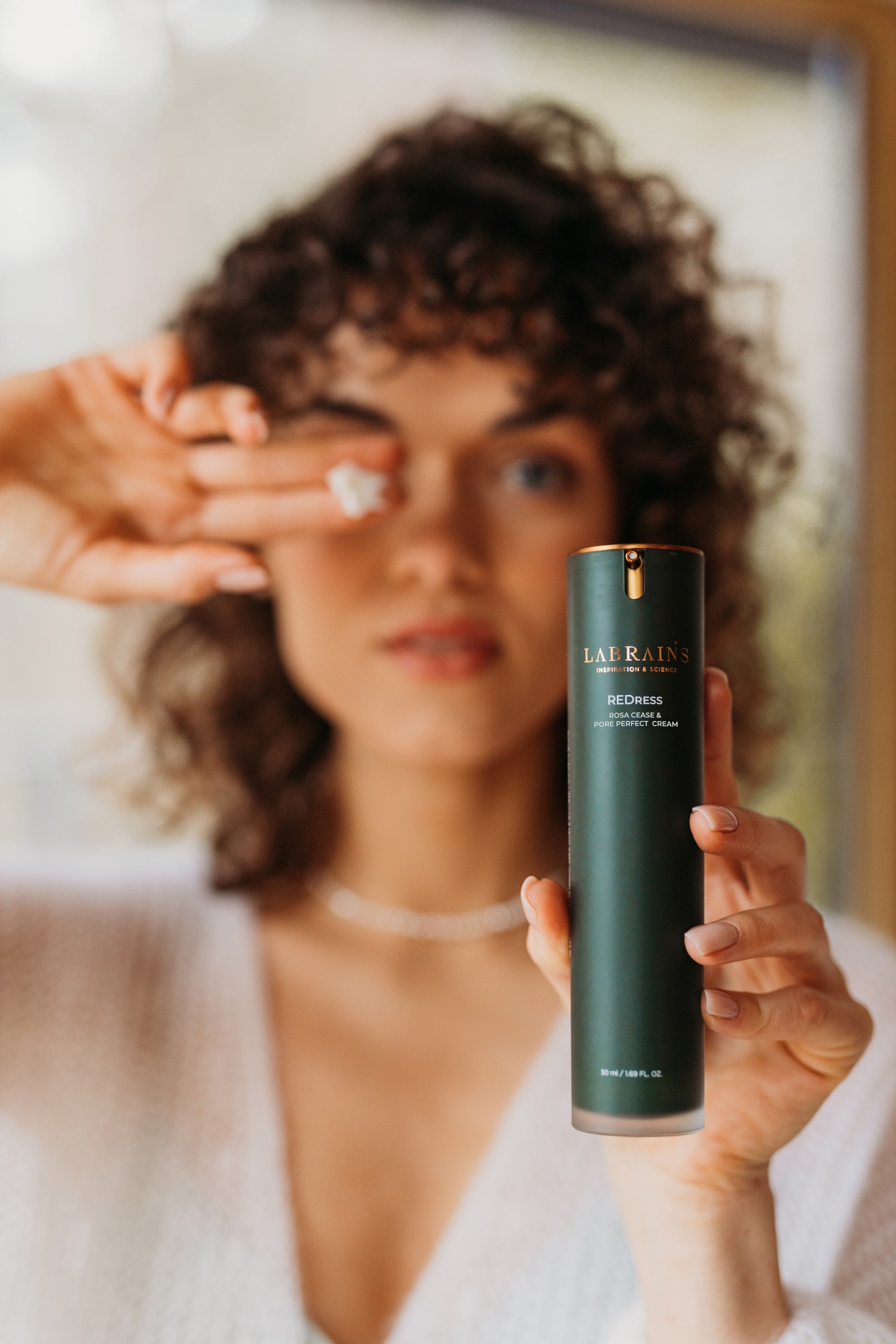
Preparing Rosacea Skin for Aesthetic Treatments
If you’re undergoing hydra-facial, laser therapy, plasma injections, or microneedling to improve rosacea symptoms, capillary damage, or skin texture, it’s essential to prepare the skin properly beforehand.
Many conventional skincare products (especially those containing PEGs, silicones, and synthetic emulsifiers) create a false illusion of hydration, while actually disrupting long-term skin health. To get the best results from aesthetic treatments, your skin should be filled with real nutrients and hydration—not covered with a synthetic film.
LABRAINS products help prepare the skin for procedures by:
- Strengthening the skin barrier to prevent excessive post-treatment sensitivity.
- Providing deep hydration with bioavailable oils and humectants.
- Supporting microbiome balance to minimize post-procedure breakouts.
- Offering post-treatment anti-inflammatory care to speed up recovery and reduce redness.
Mandatory Post-Treatment Products for Rosacea Skin Recovery:
✔ Rosa Cease Care Serum & Rosa Cease Creams – Calm inflammation, reduce redness, and support capillary repair.
✔ Pore Perfect Serum – Controls post-procedure inflammation & prevents clogged pores.
✔ Micellar Water & Tonic – Ensures gentle hydration and microbiome support without harsh preservatives.
Conclusion: Strengthening Skin Tolerance & Preventing Rosacea Flares
Rosacea is not just about treating symptoms - it’s about strengthening the skin’s long-term resilience. By combining a well-structured cleansing routine with microbiome-safe skincare and aesthetic treatments, you can significantly improve your skin’s health and tolerance.
✔ LABRAINS all products are tailored for sensitive skin avoiding all potential allergens and irritants that disrupt our skin, 100% sulfate-free, fragrance-free, alcohol-free, and PEG-free - preventing irritation.
✔ Our formulations balance cleansing and protection, preventing the overwashing cycle that worsens rosacea.
✔ All LABRAINS products can be seamlessly integrated into a rosacea skincare routine, tailored to individual needs.
Remember: Rosacea skincare isn’t just about what you apply - it’s about the long-term health of your skin.
With LABRAINS, you’re not just treating rosacea - you’re strengthening your skin for the future.
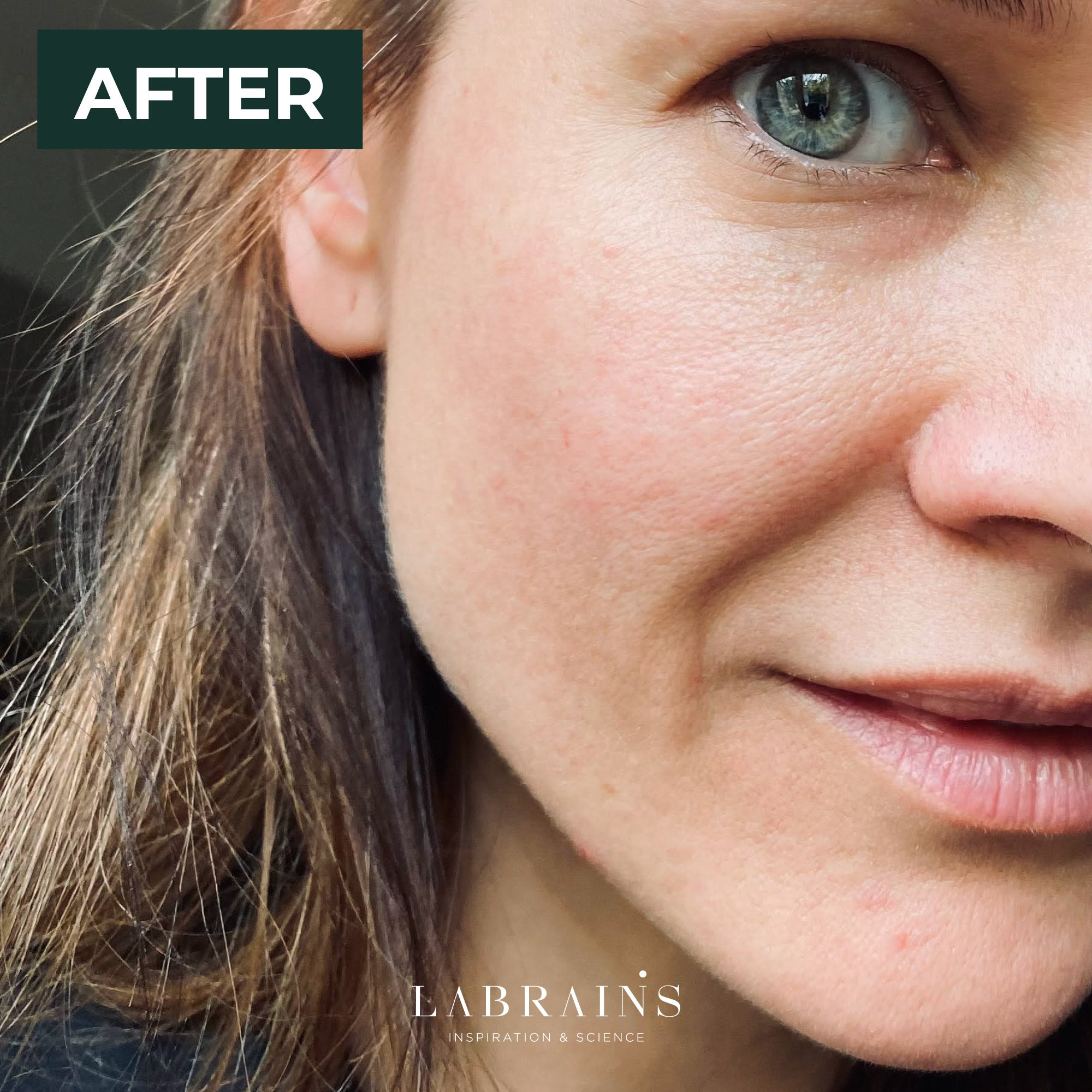
Final Words: Rosacea Requires Strategy, Not Speed
Rosacea is lifelong. But your approach to it determines how it shows up in your life.
- Understand your triggers;
- Commit to daily skincare that supports, not disrupts;
- Use multifunctional products that repair, protect, and calm;
- Live anti-inflammatory - from diet and stress, to air quality and fabrics;
- Pair professional treatments (lasers, plasma, microneedling) with nutrient-rich skincare to maximize results.
At LABRAINS, we offer science-led, patient-safe solutions for rosacea. And above all, we never gamble with sensitive skin.
Choose care over cover. Choose LABRAINS.

